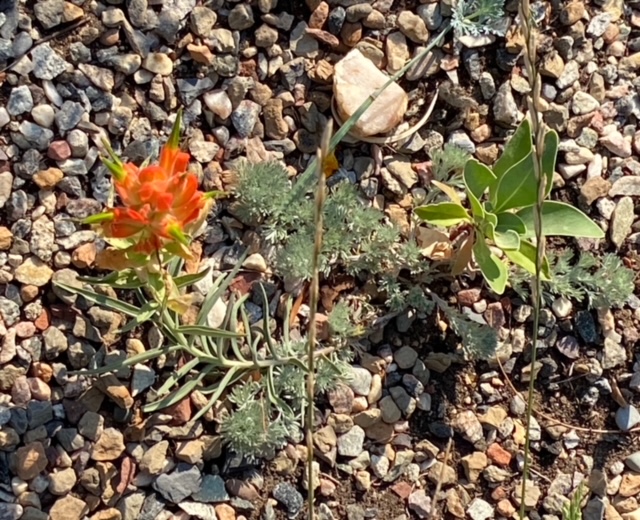By Jan Midgley
Also known as Prairie Sagebrush or Fringed Sage, the soft mounding mat of silvery gray green foliage typical of Artemisia frigida is an excellent matrix for a garden bed of native grasses and forbs. This is a sensory plant: soft to the touch, sweet smelling, edible and visually soft and soothing. It is an excellent foil for chartreuse yellows and deep blues. As a bonus, it is an excellent host plant for Castilleja spp., the flashy paintbrushes.

Sometime between July and October, heads of chartreuse disc flowers form a 12-18” tall spike or panicle that nods above the 4-8” tall mound of non-flowering stems. The leaves on these short stems are alternately divided into linear segments. The leaves look silvery because they are covered with long silky hairs.
During the active growing season for this perennial or subshrub, growth proceeds underground as well as above. Rhizomes extend and produce new shoots. In arid but friable soil, a tap root may develop. These underground structures help this species regenerate after fire.
About 8-12 weeks after bloom, the flowers mature and fade to a tan yellow. The seeds (achenes) are smooth, tan and very small. They have no feathery pappus. The platform for the disc flowers does have long hairs but no chaffy receptacle bracts.
During severe drought (such as in 2020), the plants produced fewer flower spikes in natural areas. This was true of other species of sagewort as well. Producing seeds requires nourishment. Luckily seeds remain viable in the soil for many years so the plant can replace itself if established plants perish from drought or fire.


The range of Fringed Sage in North America is extensive, growing throughout almost the entire western half of the United States. It extends into Canada and has been introduced into north central and eastern states. It also occurs in northern Europe and Asia. Perhaps tolerance for heat and extreme cold as well as various elevations and exposures may account for this wide range.
Naturally, it is found in full sun or even open forests in the Plains, Foothills, and Montane Life Zones, from 4000-10,000 (12,000) feet. It can be found on flatlands or slopes, usually in gravelly soil.
In cultivation, plant it in lean, dry, alkaline, well draining soil in full sun to partial open shade. It will grow in heavy clay soils as long as it is not irrigated. It is especially tolerant of heavy soil if it is planted with prairie grasses. When first planted, water every other day for 4-6 weeks. Taper the regularity of watering gradually. No supplemental irrigation should be required in subsequent years. If mulching, a mineral mulch of varied sizes of gravel is preferable to wood mulch.
Artemisia frigida can remain green over winter. If the herbaceous stems die back, they will resprout from a woody base. Anytime after the flower stems dry, shear the foliage to 4”. To benefit insects, wait to shear it until just before active growth begins in the spring. An insect or two might just overwinter in the foliage.
Elk and deer may lightly browse this sage in winter and spring, but the species is a more important food source for small mammals and birds.
Propagate Fringed Sage from seeds, cuttings, division or layering. Collect seeds from September to November. Crush the heads and remove the involucral bracts. When cleaning by hand, it can be difficult to separate the seeds from the corollas, bracts and long receptacle hairs. This extraneous matter will not prevent the seeds from germinating. Store the seeds dry at 40˚ or 70˚F for 6 months before sowing. This allows the embryo to mature (afterripen).
In spring after the last frost date, sow the seeds on a well-draining medium. Cover the seeds lightly with fine vermiculite. Aim for a daytime temperature of 70˚F whether in a greenhouse under mist or outside. When starting the seeds outdoors, mist several times a day or create a high humidity tunnel and place it in partial shade. Seeds should germinate in 3-10 days. When potting the seedlings, use a 2.5”x3” deep pot filled with a well draining medium. Water to establish the young plants but avoid overwatering.
Take 2” tip cuttings from February to May before flowering. Avoid stems with flower buds. Dip in hormone powder or a liquid hormone. Stick in a well draining cutting medium. Place under mist or outside in shade with bright light.
Artemisia is wind pollinated, but insects do visit. The genus is a host plant for 44 species of Lepidoptera according to the National Wildlife Federation’s Plant Finder for Front Range zip code 80226.
Artemisia frigida has been used by indigenous peoples and Hispano Americans to treat stomachaches, coughs, gynecologic ailments and nosebleed (braid of sagebrush around the forehead). It has a strong menthol taste. It is also a serviceable toilet paper.
This beautiful useful plant can thrive in gardens throughout Colorado.
Curious to learn more about transforming your garden into a habitat with Colorado native
wildflowers, grasses, shrubs, and trees? Check out our native gardening toolkit, register for an
upcoming event, subscribe to our newsletter, and/or become a member – if you’re not one already!
